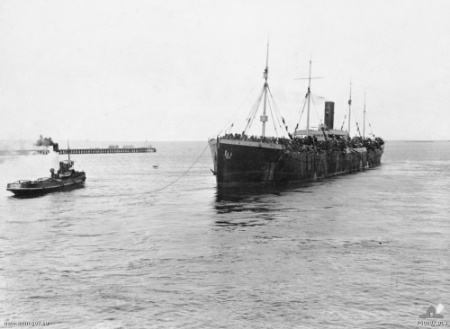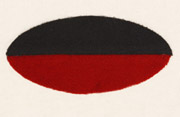 |
|||||||||||
|
|
|||||||||||
 |
|
It is very hard to re-create the life a person whom no-one alive today has memories of. Alf was Esthers favorite brother. This photo card was taken in England before they went to France. There is a line to indicate that they had visited Cousins and Uncles (and Aunts I assume) in England. Alf was killed in 1918 6 weeks before the war ended. See the diggers page for more details. His brother George spoke very little about the war so much history has been lost. In May 2010 I came across a photo taken a week before he was killed, see below: |
 |
|||
 |
|||
|
|
||||||||||||||||
 |
|
|
Alf joined as part of the 37th Battalion and left Australia on the Royal Mail Steamer Persic, These ships carried mail between Australia and the United Kingdom. Occasionally, they carried small numbers of passengers as well, including, on occasion, troops. Above is an ACTUAL photo of the Troop Ship A34 (Royal Mail Steamer) Persic leaving Melbourne on June 3rd 1916 with Alf Muston and the 37th Batallion on board. Taken by Josiah Barnes on the day of departure. If Alf was one of the men up front waving then this was the last pic taken of him in Australia. More about troop ships at this site, click here
|
From records obtained by David Murrel it is clear that he was killed in the battle of the St Quentin Canal on Sept 29th. See details of this battle below. Apparantly the engineers had been sent out the day before the battle to build roads and put up phone lines into no-mans land, and he was shot in the leg and died from the wounds. I had a computer crash and lost what david sent me so will endeavour to upload it when I get another copy of the details.
The Tincourt Cemetary where he is buried is a few miles north east to St Quentin township.
The 37th was disbanded just after his death but he is listed as fighting with the 3rd Pioneers when he died. Others from the 3rd Pioneers are also buried at Tincourt.
37th Battalion
The 37th Battalion was formed, as part of the 10th Brigade of the 3rd Australian Division, in February 1916 at Seymour in Victoria. Its recruits were drawn from Melbourne, north-east Victoria and Gippsland.
After training in both Australia and Britain, the battalion moved to France on 23 November 1916. Within a week it had begun to occupy trenches on the Western Front, just in time for the onset of the terrible winter of 1916–17. During this time the 3rd Division was heavily involved in raiding the German trenches. In February 1917 the 37th Battalion provided 400 troops, with a similar party from the 38th Battalion, to form a special raiding “battalion”. After several weeks of training this force staged a single 35-minute raid on the night of 27 February and was then disbanded
The 37th fought in its first major battle at Messines, in Belgium, between 7–9 June 1917. For his actions during this battle, Captain Robert Grieve was awarded the Victoria Cross. The battalion fought in another two major attacks in this sector – the battle of Broodseinde on 4 October, and the battle of Passchendaele on 12 October. Belgium remained the focus of the 37th Battalion’s activities for the next five months, until it was rushed south to France in late March 1918 to meet the German Army’s Spring Offensive.
The Allies launched their own offensive on 8 August 1918, but the 37th Battalion was in reserve on this day and was not ordered into action. It was involved, however, in an ill-conceived attack that failed to capture the village of Proyart on 10 August. The battalion nevertheless continued to play an active role throughout August and early September in the 3rd Division’s advance along the Somme Valley.
Despite its success, this advance sapped the strength of the AIF. In September 1918 several battalions were ordered to disband to provide reinforcements for others. The 37th was one such battalion. Its CO, Lieutenant Colonel Charles Story, was dismissed for questioning the order in letters written to all of his superior commanders, including the Prime Minister. The men of the battalion subsequently mutinied. On 23 September the order to disband was temporarily suspended, and the battalion fought its last battle – St Quentin Canal – six days later. On 12 October 1918 the 37th Battalion, then with a fighting strength of 90, disbanded.
Colour Patch
Glossary
10 Brigade ; 1st Australian Imperial Force ; 3 Division ; Battle of Amiens ; Battle of Broodseinde Ridge ; Battle of Messines ; First Battle for Passchendaele ; Proyart ; German Spring Offensive ; Grieve, Robert Cuthbert ; St Quentin Canal
Battle Honours
- Messines 1917
- Ypres 1917
- Polygon Wood
- Broodseinde
- Poelcappelle
- Passchendaele
- Somme 1918
- Ancre 1918
- Amiens
- Albert 1918
- Mont St Quentin
- Hindenburg Line
- Hindenburg Line
- St Quentin Canal
- St Quentin Canal
- France and Flanders 1916-1918
Casualties
- 483 killed, 1485 wounded (including gassed)
St Quentin Canal
Originally built to connect the Somme and Scheldt Rivers, the Germans utilised the St Quentin Canal as an additional defensive barrier forward of the Hindenberg Line. East of Peronne the canal ran through a tunnel for approximately six kilometres between Bellicourt and Venhuille. As this "bridge" over the canal formed an obvious point at which to attack the Hindenburg Line it was heavily defended.
Fearing an attack across the canal would be costly, Lieutenant General Monash decided to assault over the top of the tunnel. With the Australian Corps exhausted from almost continuous operations since 8 August, Monash had only two divisions in a reasonable state for combat - the 3rd and 5th - and was thus reinforced with the 27th and 30th United States Divisions. The plan was for the numerically superior Americans to breach the Hindenburg Line above the tunnel, and another defensive line a kilometre to the rear. The Australians would then pass through and assault the Beaurevoir Line, another four kilometres back. The attack would be supported by 90 tanks and heavy artillery concentrations.
The inexperience of the Americans was telling. An operation launched to secure the start line on 27 September 1918 was unsuccessful due to their failure to properly clear dugouts and trenches. The same mistakes were repeated by the 27th Division when the actual attack was launched two days later. The 3rd Australian Division, trying to advance to its own start line, became embroiled in the fight for the Americans' first objective. With all of the tanks destroyed or disabled, and the uncertain position of the forward troops preventing the use of artillery, the battle degenerated into a struggle for individual strong points, fought with bombs, bayonets and Lewis guns, that lasted for another three days. The 30th American Division, attacking further to the south, was more successful, enabling the 5th Australian Division to pass through and capture the heavily fortified village of Bellicourt. Their progress, however, was hampered by the lack of it in the north.
Even further south the British 9th Corps had managed to cross the canal, breach the Hindenburg Line, and begin advancing upon the Beaurevoir Line. This action threatened to outflank the positions along the tunnel, resulting in a gradual German withdrawal that began on the night of 30 September. By 2 October a gap of approximately 17 kilometres had been opened in the Hindenburg Line. The operation had cost the 3rd and 5th Australian Divisions 2,577 casualties.


